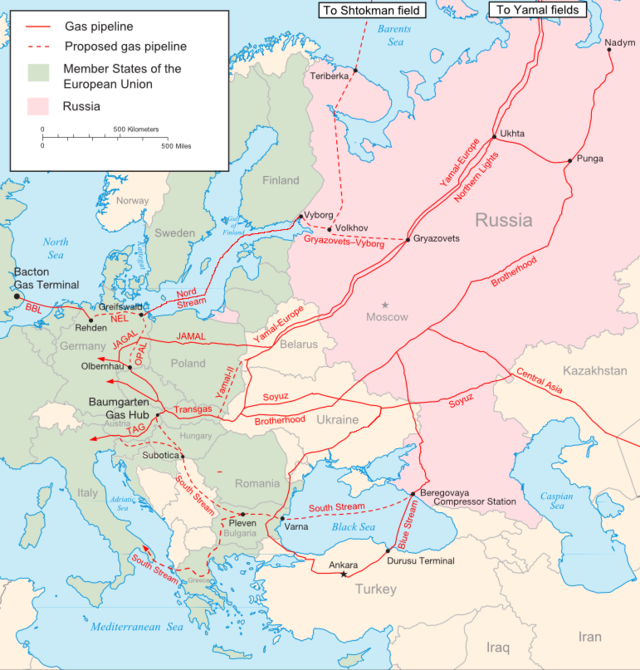October 10-14

The European Union is desperate to reduce its dependence on Russian natural gas, but the only large supply of untapped gas in the world is in the Islamic Republic.
This poses a major conundrum for everyone.
First, the EU can’t tap Iranian gas while the nuclear issue remains unresolved. The EU made a decision some years back to ban all natural gas imports from Iran until the nuclear problem has been concluded. There are some people within the EU who would like to change that. But there is no indication any government that matters is even thinking of modifying that policy.
Second, Iran sees Europe as the one big market available for its gas and is eager to sign up buyers there—but it has grown dependent on Russia politically and fears angering Moscow by selling to the EU. Tehran is so fearful of offending Moscow that President Rohani last week publicly assured the Russians that Iran has no intention of trying to supplant Russia in the EU gas market.
Third, the Russians under Putin don’t really trust Iran. (They don’t really trust anyone, for that matter.) Moscow appears eager to lock Iran in its embrace, but with the stipulation that Moscow’s benefits for Iran will flow only if Iranian gas does not. It has undoubtedly not gone unnoticed in Moscow that Iran’s newly-named ambassador to Germany is Ali Majedi, who until now was deputy oil minister in charge of international affairs.
All of this back-and-forth needs to be put into some perspective. The problem for Europe getting Iranian gas isn’t just a matter of the nuclear clash. It’s also a matter of infrastructure. There is simply no way to get massive quantities of Iranian gas to Europe yet and pipelines will take years to build. Even if work started tomorrow, it isn’t likely any significant quantity of Iranian gas would reach Europe until the 2020s.
A European Commission source involved in developing EU energy strategy told Reuters, “Iran is far towards the top of our priorities for mid-term measures that will help reduce our reliance on Russian gas supplies.”
But this source also said. “There is a clear rapprochement between Tehran and the West.” That is a common view among many, but does not reflect what the foreign policy makers are saying in any major capital in Europe.

Russia is currently Europe’s biggest supplier of natural gas, meeting a third of its demand worth $80 billion a year. The EU has imposed sanctions on Moscow over the conflict in Ukraine, increasing the need for gas from elsewhere.
While sanctioned itself, Iran has the world’s second largest gas reserves after Russia.
Reuters reported that a paper prepared for the EU’s Directorate-Generale for External Policies looked to Iran as an alternative source, but the paper added that Iran was not a credible alternative energy supplier in the short-term due to sanctions and large infrastructure needs before exports become viable.
The Islamic Republic, meanwhile, is doing a political dance.
“Iran can be a secure energy center for Europe,” President Rohani was quoted last month telling Austrian President Heinz Fischer in New York.
But that’s not what he said last week in an interview on Russian television.
“Today’s conditions are not such that if Russia stops selling gas to Europe, Iran can serve as an alternative for Russia’s gas exports to these countries….
“We are lagging in production and think about domestic consumption first,” Rohani told Russia-2 in an interview.
“From time to time, we have problems during winter and then, you know, we have many buyers, clients around us…. All our neighbors to the east, west and south want to buy gas which we are yet to produce,” he said.
“Conditions today are not such when everybody would think that if Russia stops gas supplies tomorrow then this gas would be supplied by Iran,” Rohani assured. “Our production is far from this stage yet.”
Everything Rohani said was true. But what he avoided saying in Russia is what Iranian officials have been telling the Europeans for years—that it is eager to get the ball rolling and build the pipelines so that Iran can start pumping gas to Europe as South Pars gasfield production climbs higher and Iran begins to have an excess.
Amir Handjani, an independent oil and gas specialist working in Dubai, told Reuters, “Iran is trying to position itself in Europe as an alternative to Russian gas. It’s playing a very sophisticated game, talking with Russia on the one hand about cooperation on easing sanctions and also talking to Europe about substituting Russian gas with its own.
“Given Russia’s current strategy politically, which is one of confrontation with Europe, I see the EU having little choice but to find alternative gas supplies,” he said.
Analysts say Iran has already lost out on lucrative liquefied natural gas (LNG) exports to Asia, where customers pay the highest prices, to rival Qatar.
Iran has long lobbied to build a designated pipeline across Turkey that would connect its South Pars gasfield with European customers—the so-called Persian Pipeline.
“It’s an extremely ambitious project,” Handjani said. “Even if half of it gets built, it would be major accomplishment for both Europe and Iran.”
Investors in Europe, as well as the European Commission, favor the cheaper, and politically less controversial, option of importing Iranian gas to the EU via Turkey by extending pipelines that already exist or are currently being developed.




















